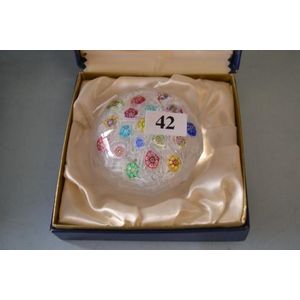Royal Worcester Menu Vase with Foliage and Gilt Edge
You must be a subscriber, and be logged in to view price and dealer details.
Subscribe Now to view actual auction price for this item
When you subscribe, you have the option of setting the currency in which to display prices to $Au, $US, $NZ or Stg.
- Rustic - Rustic is defined as "of, relating to, or typical of country life or country people", and the items illustrated in this price guide accord with that definition.
But in the 18th and 19th century "rustic furniture" had a narrower definition. It referred to furniture where the framework was carved or moulded to resemble tree trunks and branches, and was usually for outdoor use. Rustic furniture was made in cast iron, wood, terracootta and concrete. Much of the Coalbrookdale company's cast iron furniture was of rustic design. - Creamware - Creamware, also known as "Queens Ware" is the
cream-coloured English earthenware developed by Josiah Wedgwood in the 1760s.
The invention of creamware was the result of experimentation in order to find a
British substitute for imported Chinese porcelain, and the cream colour was
considered a fault at the time. The lightweight fine white earthenware with a
clean rich yellowish proved ideal for tableware
and decorative items during the 18th and 19th centuries and is still produced
today.
Creamware is made from a
mixture of kaolin, feldspar, and ball clay, and is typically glazed before
firing to give it its glossy finish. It was developed by British potters as a
cheaper alternative to porcelain.
At Wedgwood, Royal patronage
boosted sales. In 1765 Queen Charlotte, the consort of King George III placed
an order for a 12 place tea set and allowed Wedgwood to use the name
"Queens Ware" for the line. In 1770 Wedgwood produced a creamware
dinner service of 952 pieces supplied to Catherine II the Great of Russia.
Other potteries such as
Doulton, Neale & Co. and Spode produced smaller quantities of creamware.
Creamware continued to be
made throughout the 19th century and later.
This item has been included into following indexes:
-
Royal Worcester (England), item types
- other 3,388
- vases, other 1,161
Visually similar items

A Dehua figure group, early Qing dynasty, 17th/18th century, depicting Guanyin seated on a rockwork platform, flanked by two pedestals, one supporting a vase and the other, a bird, two attendants standing at her feet beside a dragon, holding a child juggli

Baccarat paperweight, spaced millefiori on muslin ground, faceted sides (in case)

A silk scarf by Christian Dior, styled in a brown, yellow and pink floral design, 90 cm square

Korowai Cloak. This korowai has doublepair twining with two areas of tailored shaping; crafted from candlewick and highlighted with a border of feathers the central area with rectangular and triangular feathered designs. Height 103 cm. Width 112 cm. Privat
